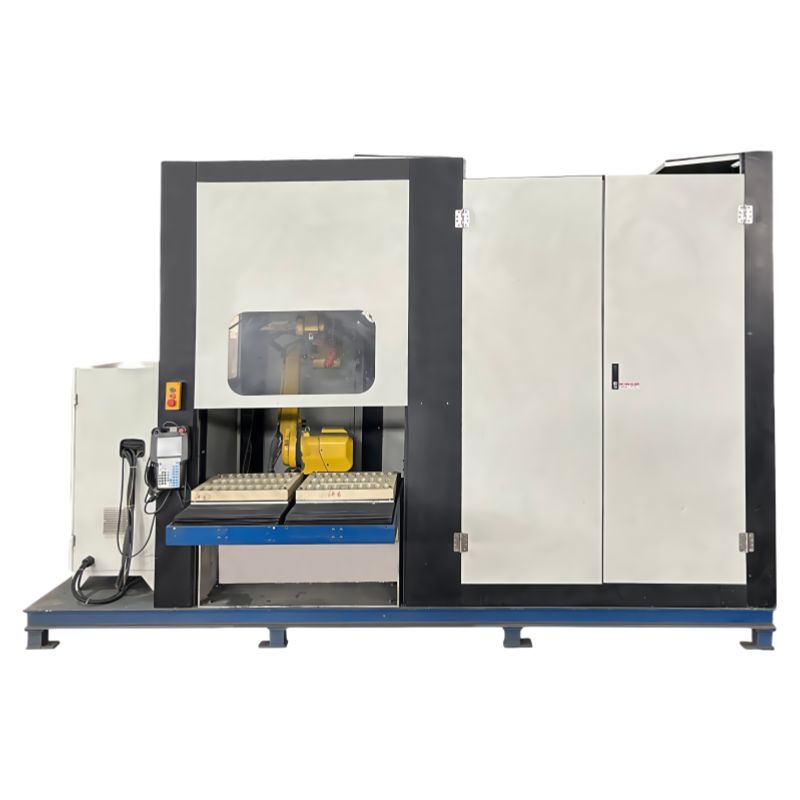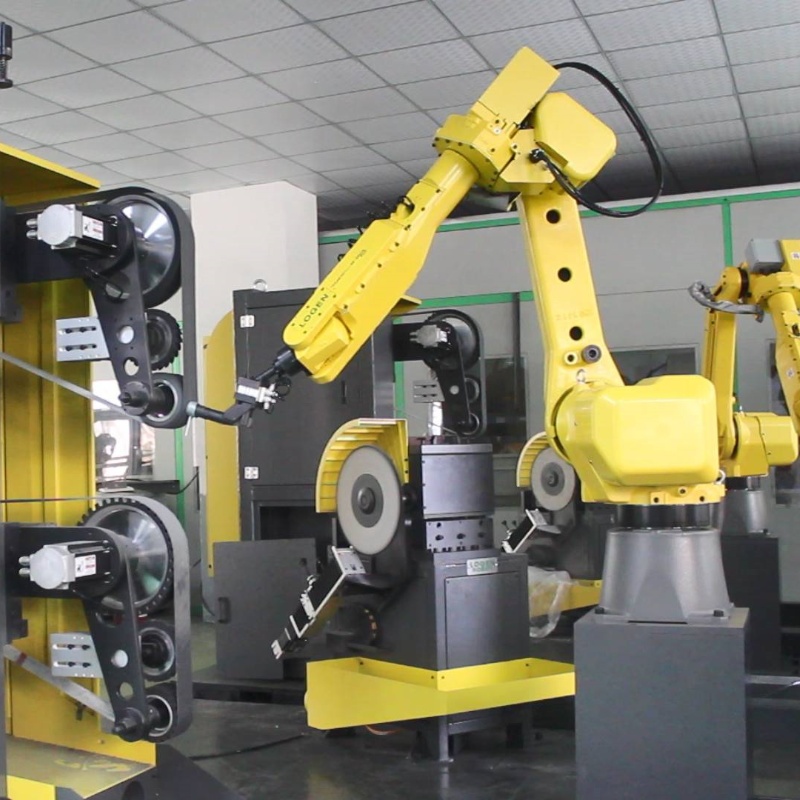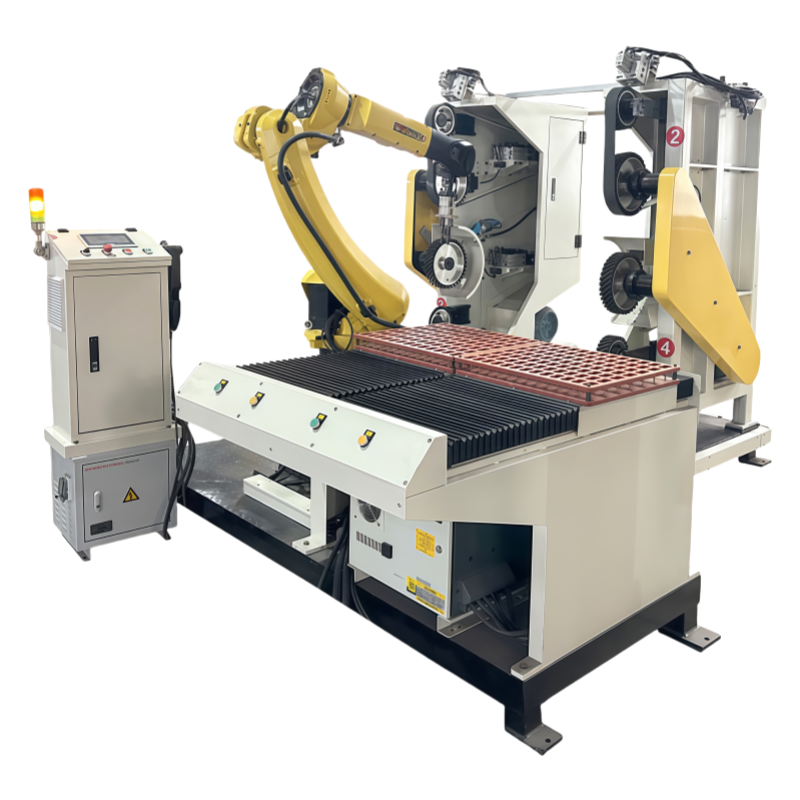FANUC Robotic Grinding and Polishing Cell for Brass Sanitary Faucets is an automated system designed to perform essential tasks such as grinding, sanding, deburring, polishing, and buffing of brass faucet parts. This system ensures high precision, consistent quality, and enhanced production efficiency. Here's an in-depth look at the functions and capabilities of this advanced robotic cell tailored for the sanitary faucet industry.

Robotic Cell for Deburring, Belt-Grinding, and Polishing for Single Handle Bathroom Faucets
A robotic cell for deburring, belt-grinding, and polishing is an advanced automated system designed specifically for processing single handle bathroom faucets. This system integrates multiple functions into one cell to handle the various stages of surface finishing, such as deburring, grinding, and polishing, to ensure high-quality, consistent results with minimal manual intervention. Here’s an overview of the system's features and functions:
Key Functions of the Robotic Cell
Deburring:
Purpose: Deburring removes sharp edges, excess material, and burrs from the faucet after the casting or machining process. It improves the safety and quality of the finished product.
Process: The robotic system uses specialized deburring tools like abrasive brushes, rotary discs, or flexible belts. These tools gently remove the burrs and sharp edges, ensuring a smooth, rounded finish that is safe to handle and meets quality standards.
Benefit: Ensures that the faucets have no sharp edges that could cause injury or affect their performance. The automated deburring process enhances precision and consistency.
Belt-Grinding:
Purpose: Belt-grinding is used for the initial material removal process to shape and refine the faucet parts. It smooths rough surfaces left after casting or machining and prepares them for further finishing steps.
Process: The robotic arm is equipped with a belt grinder that moves along the faucet's surface, removing excess material and smoothing rough areas. The system automatically adjusts the pressure and speed of the grinder based on the part’s specific requirements.
Benefit: This ensures uniform grinding across all faucet parts, reducing inconsistencies and providing an even surface for the polishing stage. It also enhances dimensional accuracy.
Polishing:
Purpose: Polishing gives the faucet a shiny, smooth, and reflective finish, making it aesthetically pleasing and resistant to tarnishing or corrosion.
Process: After the grinding process, the robotic system switches to polishing tools, typically made from cloth or foam, combined with polishing compounds. The robot carefully polishes the surface, moving across different areas of the faucet part to achieve a mirror-like finish.
Benefit: Polishing not only improves the visual appeal of the faucet but also provides a smooth surface that helps resist dirt and water buildup, which improves the faucet's overall durability and maintenance.
Process Flow of the Robotic Cell
Part Loading:
Deburring:
Belt-Grinding:
Polishing:
Once the faucet is ground to the correct shape, the polishing step takes place. The robot uses polishing pads, cloths, and polishing compounds to achieve a high-gloss finish on the faucet's surface.
Inspection:
After the deburring, grinding, and polishing processes are completed, the system may include automated quality checks, such as vision systems or sensors, to detect any defects or inconsistencies in the finish.
Part Unloading:
Benefits of the Robotic Cell
Efficiency: The robotic cell automates the deburring, grinding, and polishing processes, significantly reducing manual labor and increasing throughput.
Consistency: By using robots, the process ensures consistent quality and precision across all faucet parts, which is crucial for mass production.
Cost Savings: Automation reduces the need for manual labor, lowers production costs, and improves overall manufacturing efficiency.
Safety: Automation minimizes the handling of sharp edges and reduces the risk of worker injury during deburring and polishing operations.
Customization: The robotic system can be adapted to handle different faucet designs and sizes, making it versatile for various types of bathroom faucets.
Applications
Single Handle Bathroom Faucets: Specifically designed for the efficient deburring, grinding, and polishing of single-handle faucets used in bathrooms.
Plumbing Components: Can also be used for similar parts in plumbing applications that require deburring, grinding, and polishing.
Other Bathroom Fixtures: The system can be adapted to handle other bathroom accessories such as showerheads, towel bars, and decorative handles.
Conclusion
The robotic cell for deburring, belt-grinding, and polishing is an advanced and automated solution for processing single handle bathroom faucets. This system enhances production efficiency, ensures consistent high-quality finishes, and reduces labor costs by integrating deburring, grinding, and polishing into one seamless operation. By automating these processes, manufacturers can produce high-quality, precise, and visually appealing bathroom faucets with minimal human intervention, leading to increased productivity and cost savings.













